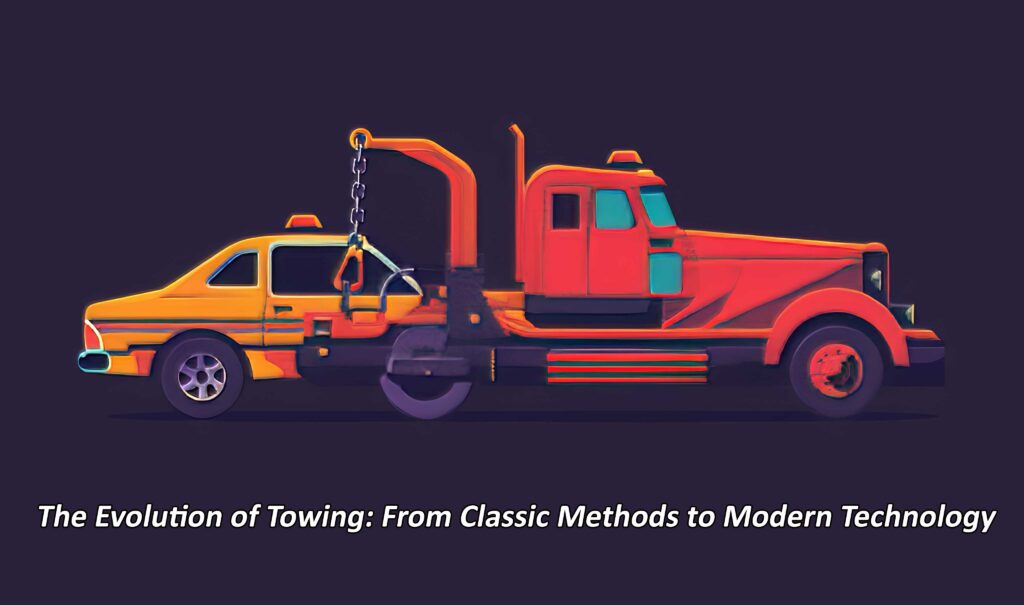Towing has advanced significantly since its inception, becoming a more complex machine with technologically advanced equipment. This has affected all towing services and how they handle emergency roadside assistance services. To car owners and enthusiasts, knowing these changes can mean seeing the direction of this field and what is more likely to come next. This article will explore The Evolution of Towing from classic methods to Modern Technology.
The Evolution of Towing: From Classic Methods to Modern Technology

The Origins of Towing Early Methods and Tools
The term towing can described through the history of the early 20th century when the use of automobiles was on the rise. Many years ago, towing was a labor and manual-intensive process whereby vehicles had to be physically dragged to the required destination. People used to pull vehicles stuck in the ditches using horses and carts and tow them to the workshops. Despite being efficient, this method was timely and needed a large workforce.
The Rise of the Tow Truck: A Game-Changer
The transformation in towing history occurred in 1916, when another mechanic named Ernest Holmes Sr., from Chattanooga, Tennessee, designed the first tow truck. The challenge of recovering cars with mere ropes and human force made Holmes develop a preliminary model known as ‘Holmes 1913 Cadillac,’ a vehicle fitted with a hand-operated crane and pulleys. This invention changed the industry by reducing the time and effort needed to tow a car.
Technological Advancements in Tow Trucks
After the invention of the tow truck, other developments have come in handy in producing new models. The application of hydraulics increased its power and versatility in lifting more than the use of levers and pulleys. Winches and boom designs have changed through the years, allowing easier towing of vehicles of different sizes and capacities.
Flatbed Tow Trucks: Their Use and Importance
Modern vehicles are so complex that flatbed tow trucks are gradually gaining popularity because they can tow them without scratching. Compared with other tow trucks, flatbeds allow cars to driven up and loaded, reducing the chance of scratching or damaging the vehicles.
The Place of Safety in Towing Advancements
Since the early days of towing, safety has been high on the list of priorities among the factors that have motivated technological changes in the segment. The newly developed tow trucks have better brakes, automatic transmissions, and control systems, making them safe for operators and vehicles.
Eco-Friendly Towing Solutions
With increased attention to environmental issues, the towing industry encourages environmentally friendly alternatives. Responsible towing is becoming more popular as firms consider environmentally friendly options such as using new fuels, electric towing tractors, and ecologically friendly towing techniques.
Towing Technology for the Modern Driver
Today’s drivers reap the benefits of improved towing technology and machinery in more effective, efficient, and safer roadside assistance services. Most companies making cars today incorporate embedded assistance assets, which use GPS to locate nearby towing companies instantly.
Challenges Facing the Towing Industry
However, this towing industry still has unique challenges despite the available technological developments. There are various challenges, but the main one is the need for proper regulation of the towing industry to prevent rogue towing companies from charging unsuspecting consumers exorbitantly high fees. Compliance with safety standards and the presence of a well-trained labor force are perpetual challenges.
The Importance of Training and Certification
As new car models and towing machinery appear, broad training and certification for tow truck operators are essential. Appropriate training guarantees that the operators are qualified enough to handle different towing complications competently.
Towing Capacity Explained: What you Need to Know
Towing services and community support.
Apart from giving services regarding roadside assistance, towing service providers act as a crucial component of the local economy. Most are involved in safe driving campaigns, vehicle donations, and charity events and support the communities in which they are found.
The Future Trends of Towing Technology
With an eye to the future, progressive changes and developments are on the horizon for the towing industry. Solutions utilizing autonomous vehicles and artificial intelligence may become one of the keys to even higher efficiency and accuracy of towing in the future.
Conclusion
This ability to learn and grow is seen all over the towing industry, where something that was once primitive has been pushed to the technological levels we are witnessing today. This information is very helpful to individuals, specifically car owners and auto enthusiasts, who want to grasp the relevance and significance of towing technology in our society.
Therefore, future advancements in the towing industry will be fuelled by technology advancement, environmental impacts, and efficiency, couched in safety and societal responsibility. Anyone who wants to discover more about the current trends and evolutions in towing technologies should read on to discover more about the future trends to expect in this sector.
